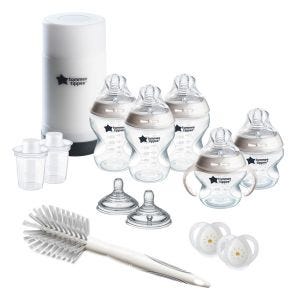
This is a demo store. No orders will be fulfilled.
Subscription orders can be cancelled at anytime. Free delivery on all subsequent subscription orders. Find out more about subscriptions.
They’re easy and fuss free
Your products are automatically sent to you
You save up to 10% when you sign up for a subscription
You can cancel at any time


Before you use your bottles for please do the following:
When using your nipples, remember to…
Please note…
Natural Start® Nipples FAQs & Troubleshooting
The valve will work wherever it’s positioned but the best place for the valve is at the top, near your baby's nose.
No, you can’t use Natural Start nipples on Advanced Anti-Colic bottles. Natural Start nipples have a built-in air valve, and don’t work with our Advanced Anti Colic bottles. The valve in your Advanced Anti Colic bottles is situated inside the bottle, attached to the end of the venting tube and is shaped like a star. It’s important that you make sure you match the right nipple to the right bottle.
Nipples take quite a lot of hammering from little gums and teeth, so they need to be changed regularly. We recommend replacing nipples every 2-months or at the first sign of any damage or weakness.
All our bottles except the 11oz version currently come with slow flow nipples as standard, as they’re best for newborns and most parents generally stock up on bottles before baby arrives. Our 11oz bottle comes with a medium flow nipple.
We have medium flow nipples, which most babies are ready for at around 3 months, and a fast flow nipple which is best from around 6 months. The ages are only guides though – you know your baby better than anyone and will be able to tell when they’re ready for a faster flow.
There are two reasons why a nipple will collapse, one is an indication that your baby is ready for a faster flowing nipple, or that the valve has reformed within the nipple.
Our Natural Start nipples are made from a very sensitive soft silicone, therefore they may reform when not in use for long periods of time, for example, when in storage.
You will have noticed a small tent like vent on the inside of the nipple; this should have a small slit along it, which allows the air to flow through the bottle. If this valve reseals, it will cause the nipple to collapse during a feed.
Please gently rub the end of the valve inside the nipple to allow this to pop open.
If the problem continues after the valve has been opened, it takes longer than 20 minutes for baby to finish a bottle, or if baby tugs at the nipple or baby falls asleep mid-bottle, you may need to increase the nipple flow rate.
Please note that the ages on the nipple packaging are purely a guideline and some babies will require a faster flowing nipple quicker than others.
As with other things around the kitchen, they can get a bit stained and yucky-looking in the dishwasher or even when you hand wash them (blame that Bolognese sauce or carrot soup you had last night).
Cloudy looking nipples generally occur as a result of strong cold-water sterilization. Cold water sterilization is perfectly fine, but if you’ve gone a bit over the top with the sterilization solution (it’s easily done!), it can impact the colour.
Don’t worry though, as the nipples are still perfectly safe to use, they just look a little different to the norm.
Nipples take quite a lot of hammering from little gums and teeth, so they need to be changed regularly. We recommend replacing nipples every 2-months or at the first sign of any damage or weakness.